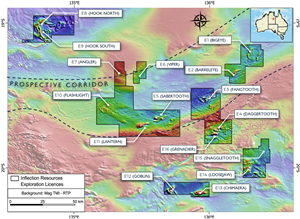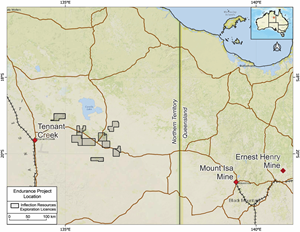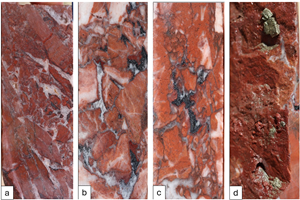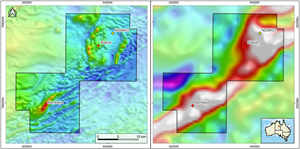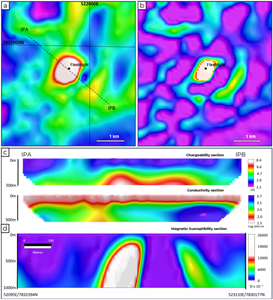Inflection Resources Outlines Large-Scale Copper-Gold Targets on the Endurance Projects, Northern Territory, Australia
VANCOUVER, British Columbia, Oct. 30, 2025 (GLOBE NEWSWIRE) -- Inflection Resources Ltd. (CSE: AUCU / OTCQB: AUCUF / FSE: 5VJ) (the "Company" or "Inflection") is pleased to provide an update on its 100% owned Endurance Projects* located in Australia’s Northern Territory. The Endurance Projects were acquired from a subsidiary of Newmont Corporation (“Newmont”) and announced by the Company on June 16, 2025.
Summary Highlights:
- The Projects are located in Australia’s Northern Territory and consist of twelve 100% owned exploration licences, totalling 4,592 km², covering sixteen large iron oxide copper-gold (“IOCG”) targets.
- IOCG deposits are among the most metal-rich mineral systems globally, with Australia's Olympic Dam, Prominent Hill and Carrapateena mines owned by BHP and the Ernest Henry mine owned by Evolution Mining being major sources of copper in Australia. IOCG deposits are attractive exploration targets due to their large scale and by-product potential, which includes gold and potentially uranium, which can greatly enhance project economics.
- The Endurance Projects are considered by the Company to be prospective for large-scale IOCG deposits of the style represented by Ernest Henry, Olympic Dam, Carrapateena and Prominent Hill mines.
- The Company considers the Endurance Projects to have the potential to represent a new IOCG province which has received minimal exploration. The projects are located in or in close proximity to a large, crustal-scale structure identified by the Australian federal government agency, Geoscience Australia and limited historic drilling which identified IOCG-style alteration and mineralisation.
- Drill core collected by Geoscience Australia, adjacent to the Bigeye (E1) target (Figure 4), contains an elemental association similar to that in hematite-rich ore zones at Olympic Dam, Prominent Hill and Ernest Henry. Furthermore, age dates obtained from the drill core suggest the area is geologically contemporaneous with the Ernest Henry IOCG mine.
Alistair Waddell, Inflection’s President and CEO, states: “We are excited to have completed the acquisition of this large portfolio of copper-gold projects in the Northern Territory. These assets strongly complement our ongoing programs in New South Wales and reinforce our strategy of drill-testing large-scale, high-impact copper-gold systems with Tier-1 discovery potential. With the exploration licences now formally transferred, we are actively advancing target prioritisation through the compilation of existing project and regional scale data and engaging with Aboriginal stakeholders. Inflection’s exploration strategy will continue to apply a mineral systems approach, utilising highest-quality geoscience to unlock the full potential of these large copper-gold targets.”
Endurance Projects:
The Endurance Project comprises twelve exploration licences totalling 4,592 km², strategically located in or in close proximity to a large, northeast-trending, crustal-scale geological structure considered by the Company to be a key fluid conduit that has the potential to localise IOCG copper-gold mineralisation (Figures 1 and 2).
These licences contain sixteen principal target areas, which typically comprise coincident aeromagnetic and Bouguer gravity highs, often with zones of elevated airborne electromagnetic (AEM) conductivity. These geophysical characteristics are similar to those at other large IOCG deposits in Australia and other parts of the world, including the Ernest Henry mine in Queensland and Olympic Dam in South Australia. The integrated geophysical signatures observed across the Endurance targets suggest the potential for IOCG alteration and mineralisation at depth.
The geology of the area is concealed beneath a blanket of younger, post-mineral rocks and alluvium cover estimated to be between 60 and 170 m thick. This cover sequence has impeded exploration in the region, leaving the prospective basement rocks largely untested despite their favourable geophysical expression. Modern exploration techniques, including high-resolution geophysical surveys and cost-effective drilling through cover, are now enabling the Company to effectively test these concealed targets for the first time.

Figure 1: Endurance Licences with principal targets on a reduced to pole (RTP) aeromagnetic map.

Figure 2: Map showing the Endurance projects and the location of other major IOCG districts.
Bigeye (E1) and Barreleye (E2) targets:
Based on work to-date, the Company considers the Bigeye target to be the most compelling and assigns it the highest priority for follow-up. The target is defined by a circular 8 km × 8 km aeromagnetic high coincident with a Bouguer gravity anomaly, positioned along a northeast-trending, crustal-scale structure interpreted to represent a major fluid conduit capable of localising mineralisation. A government-funded airborne electromagnetic (AEM) survey identified several discrete conductors close to the margin of the Bigeye circular magnetic feature, which Inflection interprets as being prospective for IOCG-style mineralisation.
A stratigraphic drill hole completed by Geoscience Australia into the northwestern portion of this target (Hole NDIBK07, Figures 3 and 4) intersected rocks which were dated and returned a maximum age of 1,652Ma, which suggests the area is geologically contemporaneous with the eastern succession of the Mt Isa Inlier, which hosts the Ernest Henry mine. Hole NDIBK07 intersected intensely hematite–pyrite altered sediments with quartz veining, which is considered highly encouraging in terms of potential prospectivity. Inflection sampled the Geoscience Australia core, which returned assay results anomalous in barium, thorium, cerium, lanthanum, and yttrium with high potassium values that reflect an elemental association similar to that reported in hematite-rich zones at Olympic Dam, Prominent Hill and Ernest Henry (Belperio et al. 2007 and Rusk et al. 2010).
Government AEM survey interpretation shows large conductors on the margins of magnetic-gravity anomalies with similar characteristics to those seen at Ernest Henry, where sulphide accumulations occur on structural margins around an intrusive complex.
Collectively, the magnetic and Bouguer gravity anomalies with AEM conductors, the Mt Isa-age basement rocks and IOCG-style alteration suggest Bigeye could represent a district-scale intrusive complex capable of hosting IOCG-style mineralisation.

Figure 3: Select core photos from drill hole NDIBK07. 254.00-272.50m: (a-d) Hydrothermally brecciated sediments with strong hematite alteration, quartz +/- specular hematite and pyrite.
The Barreleye (E2) target is an elongated, approximately 2.5 km × 0.5 km magnetic high that is coincident with a broad Bouguer gravity high, suggestive of a dense magnetic centre. An AEM conductivity anomaly is offset from the magnetic-gravity anomaly, consistent with potential sulphide accumulation on structural margins in Ernest Henry–style mineralisation. The target sits along a major structural corridor (Figure 1).

Figure 4: Maps showing Bigeye and Barreleye targets with reduced-to-pole aeromagnetic data (left), Bouguer gravity data (right) plus the collar location of Geoscience Australia drill hole NDIBK07.
Fangtooth Targets (E3):
The Fangtooth target is a coincident magnetic and Bouguer gravity high associated with a zone of elevated IP chargeability and resistivity. The Fangtooth West anomaly has dimensions of approximately 3,000 m x 1,200 m and Fangtooth East has dimensions of approximately 2,200 m x 1,200 m.
Flashlight Target (E10):
The Flashlight Target exhibits a subtle aeromagnetic high coincident with an approximate 500 m x 400 m zone of elevated Bouguer gravity, suggestive of potential magnetite enrichment. Overlapping this anomaly is a zone of elevated chargeability identified by an induced polarisation (IP) survey, which is interpreted to represent possible sulphides at depth (Figure 5). Flashlight represents a high-priority drill target.

Figure 5: Flashlight Target (a) Map of RTP Airborne magnetics with IP section line, (b) magnetic inversion model map with 350m depth slice, (c) NW-SE IP chargeability and conductivity sections and (d) magnetic susceptibility section.
Other Targets:
Angler Target (E7): An elongated, 8 km x 2 km geophysical target which suggests a coherent magnetic body coincident with a moderate gravity response and a strong, coincident AEM conductivity high. Moderate magnetic relief coincides with the gravity high, while the conductivity suggests possible sulphides adjacent to a magnetic body.
Chimaera Target (E13): A very large, 12.0 km × 2.5 km magnetic lineament with a modest gravity expression. The scale of the target suggests capacity for multiple pipe or breccia-style IOCG centres focussed along structural margins and fold hinges.
Viper Target (E6): An approximate 2,500 m × 1,200 m moderate magnetic high coincident with a gravity low and an offset AEM conductivity high. A moderate magnetic high coincident with low gravity and an offset AEM conductor suggest a discrete dense core with a potential sulphide-bearing structural zone on the margin.
Loosejaw Target (E14): Broad magnetic anomalism is coincident with a NE–SW-striking gravity anomaly, with a laterally offset AEM conductor nearby. The displaced conductivity anomaly has characteristics typical of potential sulphides on the flanks of a magnetite-bearing centre.
Lantern Target (E11): A compact, sub-kilometre magnetic high with a coincident, modest gravity high and a subtle, chargeable/conductive IP anomaly with a top interpreted to be 250 m to 300 m below surface. Scout drilling in the vicinity of the target by Newmont intersected a broad zone of disseminated pyrite in iron-rich metasediments which returned 4 m grading 0.2% Cu from 218 m.
Hook Target (E8): Two discrete magnetic high anomalies of approximately 3,000 m × 1,500 m each with coincident gravity highs.
Goblin Target (E12): A large, 5,000 m × 3,000 m magnetic anomaly coincident with a zone of subtle gravity. The magnetic geometry is consistent with a concealed intrusive centre.
Daggertooth Target (E4): A 3,000 m × 1,000 m coincident magnetic and gravity high which aligns with a strong IP chargeability anomaly and moderate resistivity contrast.
Next steps:
The Company is working through general permitting and land access agreements. While the Company is still assessing options, a program of first-pass air-core drilling across the targets in the first half of next year after the wet season is being planned. Air-core drilling is a very cost-effective method of drilling through post-mineral cover and can include short diamond-core tails into the prospective basement sequence.
Iron Oxide Copper Gold (IOCG) Deposits:
IOCG deposits are among the most metal-rich hydrothermal mineral systems, with Australia's Olympic Dam and Ernest Henry ranked as two significant deposits in terms of contained copper, gold and by-product metals.
In South Australia, the Olympic Dam Mine is one of the world's largest known deposits of copper, uranium and gold, hosted within Mesoproterozoic rocks containing Mineral Resources of 10,160 Mt at 0.26 g/t Au and 0.6% Cu, plus Ore Reserves of 591 Mt at 0.26 g/t Au and 0.6% Cu (BHP Group Limited 2025). In Queensland, Ernest Henry is a magnetite-rich breccia pipe hosted in Proterozoic volcanic rocks, containing Mineral Resources of 110 Mt at 0.77 g/t Au and 1.26% Cu, plus Ore Reserves of 78 Mt at 0.46 g/t Au and 0.76% Cu (Evolution Mining Limited 2025, June 6). Ernest Henry’s strong geophysical signature, particularly in magnetics, gravity and IP, serves as a working exploration model for Inflection’s Endurance Projects. Additionally, BHP’s Carrapateena mining operation in South Australia and the Candelaria Mining Complex in Chile owned by Lundin Mining Corporation are other examples of world-class IOCG districts.
Exploration for IOCG deposits is typically guided by integrated geophysical surveys, with gravity and magnetic data forming the foundation of target generation. The distinctive density and magnetic contrasts created by iron oxide-rich alteration systems often produce characteristic anomalies that can be detected at depth, even beneath significant cover sequences. IP surveys have proven particularly valuable in delineating sulphide-bearing mineralisation within these systems, while detailed ground magnetic surveys can help define structural controls and breccia geometries (Figure 6). The discovery of concealed IOCG deposits often requires a systematic mineral-systems approach that combines regional-scale geophysical data interpretation with geological understanding of favourable host rock sequences and key structural settings.

Figure 6: Synthesis of the hydrothermal origins of select IOCG systems, their tectonic setting and fluids involved in economic Cu-Au mineralisation (Not to scale). The schematic block models are compiled from published studies and illustrate the geometries of zoned iron oxide-alkalic-calcic-hydrolytic alteration patterns and the location of Cu-Au ore bodies (Modified from Schlegel et al., 2020) - Schlegel et al. 2025.
About Inflection’s Northern Territory Projects:
The Company is systematically exploring for large copper-gold deposits in the Northern Territory, approximately 185 km east of Tennant Creek. The Company has approximately 4,600 km² of 100% owned exploration licences covering a wide variety of large geophysical targets that were generated by Newcrest Mining Limited, subsequently acquired by Newmont Corporation and highlighted by a country-wide AEM geophysical survey and analysis by Geoscience Australia (Skirrow et al., 2019). The AEM survey highlighted large-scale, deep-seated, crustal-level structures interpreted by the Company to be ideal for hydrothermal fluid pathways critical for the formation of IOCG deposits. Initial scout drilling on several targets by Newcrest returned encouraging results, confirming the potential for large, yet to be discovered, copper-gold deposits.
References:
Belperio, A., Flint, R., & Freeman, H. (2007) - Prominent Hill: A hematite-dominated, iron oxide copper-gold system. Economic Geology, 102(8), 1499–1510.
BHP Group Limited. (2025). Annual Report 2025 – Statement of Mineral Resources and Ore Reserves. BHP Group Limited.
Evolution Mining Limited. (2025, June 6) - Annual Mineral Resources and Ore Reserves Statement [ASX Announcement].
Schlegel, T.U., Berni, G.V., Fabris, A., Verrall, M.R., Shelton, T.D., Lewis, J., 2025 - Characteristics of Curnamona Cu–Au systems and the Carrapateena IOCG deposit: Hydrothermal alteration styles and their implications for IOCG exploration, CSIRO, Australia
Skirrow, R. G., Murr, J., Schofield, A., Huston, D. L., van der Wielen, S. E., Czarnota, K., Coghlan, R. A., Highet, L. M., Connolly, D. P., Doublier, M.-P., & Duan, J. (2019) - Mapping iron oxide Cu–Au (IOCG) mineral potential in Australia using a knowledge-driven mineral systems-based approach. Ore Geology Reviews, 113, 103011. https://doi.org/10.1016/j.oregeorev.2019.103011
Rusk, B. G., Oliver, N. H. S., Cleverley, J. S., Blenkinsop, T., Zhang, D., Williams, P. J., & Habermann, P. (2010) - Physical and chemical characteristics of the Ernest Henry iron oxide copper gold deposit, Australia: Implications for IOCG genesis. In T. M. Porter (Ed.), Hydrothermal iron oxide copper-gold and related deposits: A global perspective (Vol. 3, pp. 201–218). PGC Publishing.
* Prior to finalizing the acquisition, the Endurance Project was referred to as “Tennant East”.
Qualified Person and Sampling Quality Control:
The scientific and technical information contained in this news release has been reviewed and approved by Mr. Carl Swensson (FAusIMM), a “Qualified Person” (“QP”) as defined in National Instrument 43-101 – Standards of Disclosure for Mineral Projects. Mr. Swensson is not independent by reason that he is a director of the Company’s subsidiary and a shareholder of the Company.
In presenting a number of examples in this release for comparison, the Company in no way implies that future exploration in the Endurance Project will necessarily result in the discovery of similar economic mineral deposits or mines. The QP of this news release has not verified any of the historical drill intercept mentioned. The information pertaining to the third-party owned deposits/mines and the information disclosed is not necessarily indicative of any economic mineralisation on Inflection’s projects.
Core was logged at the Northern Territory government core facility and cut to the Company’s specified sample intervals. The drill core had been previously photographed by the government. Half-core samples were placed in bags with internationally certified blanks and standards inserted. Samples were dispatched to Intertek Laboratories in Adelaide. Intertek who prepared them by crushing and grinding via method SP64. The pulps were then assayed for 48 elements via method 4A/MS48 and an additional 12 elements via method 4A/MS48R using a 25 g sample after a four-acid, near total digest with an ICP-MS finish. Gold, platinum and palladium were assayed by fire assay using method FA25/MS using a 25 g sample charge and ICP-MS finish. Laboratory standards and QA-QC are monitored by the Company using Oreas Certified Reference Materials. Coarse rejects will be subjected to short-wave-near-infrared spectral analysis which provides detailed confirmation of the hydrothermal alteration.
About Inflection Resources Ltd. Inflection is a gold-copper-focused mineral exploration company listed on the Canadian Securities Exchange under the symbol “AUCU”, on the OTCQB under the symbol “AUCUF” and on the Frankfurt Stock Exchange under the symbol “5FJ”, with projects in New South Wales and the Northern Territory, Australia. For more information, please visit the Company website at www.inflectionresources.com.
NewQuest Capital Group. Inflection is part of the NewQuest Capital Group, which is an entrepreneurial, discovery-driven investment group that builds value through the incubation and financing of early-stage mineral exploration projects globally. Further information about NewQuest can be found at www.nqcapitalgroup.com.
On behalf of the Board of Directors
Alistair Waddell
President and CEO
alistair@inflectionresources.com
For further information, please contact:
Brennan Zerb
Investor Relations Manager
+1 (778) 867-5016
Forward-Looking Statements: This news release includes certain forward-looking statements and forward-looking information (collectively, "forward-looking statements") within the meaning of applicable Canadian securities legislation. All statements, other than statements of historical fact, included herein including, without limitation, statements regarding future exploration expenditures by AngloGold Ashanti, amount of drilling, commencement and cost of exploration programs in respect of the Company's projects and mineral properties, AngloGold Ashanti’s anticipated funding of the Phase II Exploration Expenditures and timing thereof, and the anticipated business plans and timing of future activities of the Company, are forward-looking statements. Although the Company believes that such statements are reasonable, it can give no assurance that such expectations will prove to be correct. Often, but not always, forward looking information can be identified by words such as "pro forma", "plans", "expects", "may", "should", "budget", "scheduled", "estimates", "forecasts", "intends", "anticipates", "believes", "potential" or variations of such words including negative variations thereof, and phrases that refer to certain actions, events or results that may, could, would, might or will occur or be taken or achieved. Forward-looking statements involve known and unknown risks, uncertainties and other factors which may cause the actual results, performance or achievements of the Company to differ materially from any future results, performance or achievements expressed or implied by the forward-looking statements. Such risks and other factors include, among others, statements as to the anticipated business plans and timing of future activities of the Company, including the Company's exploration plans, the proposed expenditures for exploration work thereon, the ability of the Company to obtain sufficient financing to fund its business activities and plans, delays in obtaining governmental and regulatory approvals (including of the Canadian Securities Exchange), permits or financing, changes in laws, regulations and policies affecting mining operations, the Company's limited operating history, currency fluctuations, title disputes or claims, environmental issues and liabilities, as well as those factors discussed under the heading "Risk Factors" in the Company's prospectus dated June 12, 2020 and other filings of the Company with the Canadian Securities Authorities, copies of which can be found under the Company's profile on the SEDAR+ website at www.sedarplus.ca. Readers are cautioned not to place undue reliance on forward-looking statements. The Company undertakes no obligation to update any of the forward-looking statements, except as otherwise required by law.
Photos accompanying this announcement are available at:
https://www.globenewswire.com/NewsRoom/AttachmentNg/dfc64575-1aea-4218-ab5f-1195006c57c5
https://www.globenewswire.com/NewsRoom/AttachmentNg/c16c33dc-1e2f-4261-8386-c096a63bcb26
https://www.globenewswire.com/NewsRoom/AttachmentNg/57fed1a2-bcc3-4a8d-b256-89378e7f928e
https://www.globenewswire.com/NewsRoom/AttachmentNg/b42971b2-4342-4631-b5fb-18da31c2248d
https://www.globenewswire.com/NewsRoom/AttachmentNg/63539223-575c-4e67-ba63-2e3f3fe148dc
https://www.globenewswire.com/NewsRoom/AttachmentNg/41dc00a7-0921-419e-9c23-1134f9ed33d4

Figure 1
Endurance Licences with principal targets on a reduced to pole (RTP) aeromagnetic map.
Figure 2
Map showing the Endurance projects and the location of other major IOCG districts.
Figure 3
Select core photos from drill hole NDIBK07. 254.00-272.50m: (a-d) Hydrothermally brecciated sediments with strong hematite alteration, quartz +/- specular hematite and pyrite.
Figure 4
Maps showing Bigeye and Barreleye targets with reduced-to-pole aeromagnetic data (left), Bouguer gravity data (right) plus the collar location of Geoscience Australia drill hole NDIBK07.
Figure 5
Flashlight Target (a) Map of RTP Airborne magnetics with IP section line, (b) magnetic inversion model map with 350m depth slice, (c) NW-SE IP chargeability and conductivity sections and (d) magnetic susceptibility section.
Figure 6
Synthesis of the hydrothermal origins of select IOCG systems, their tectonic setting and fluids involved in economic Cu-Au mineralisation (Not to scale). The schematic block models are compiled from published studies and illustrate the geometries of zoned iron oxide-alkalic-calcic-hydrolytic alteration patterns and the location of Cu-Au ore bodies (Modified from Schlegel et al., 2020) - Schlegel et al. 2025.
Legal Disclaimer:
EIN Presswire provides this news content "as is" without warranty of any kind. We do not accept any responsibility or liability for the accuracy, content, images, videos, licenses, completeness, legality, or reliability of the information contained in this article. If you have any complaints or copyright issues related to this article, kindly contact the author above.

